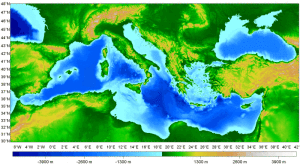Mediterranean Sea Level
Mediterranean Sea Level. There is general acceptance that, on more than one occasion, the Strait of Gibraltar was closed completely. Tectonic plate movement, worldwide sea level drops due to the onset of Ice Age glaciation or a combination of both, could have caused this. There is also clear undisputed evidence that the Mediterranean Sea has dried out completely on a number of occasions. What is not clear is when the last desiccation or partial drying-out of the Mediterranean ended. The conventional date given for the last breaching of a Gibraltar Dam is 5 million years ago. However, there is a small but growing opinion that there was a more recent breach of a dam within the memory of modern man and preserved in history and myth.
>Not only have sea levels changed, but a 2020 report has now offered evidence that the Mediterranean was over three degrees hotter 2,000 years ago and that it remained hotter for about 500 years during the time of the Roman Empire(c).<
 Where one theory on the location of Atlantis is concerned, the existence of a Gibraltar dam before the end of the last Ice Age is critical, namely that Atlantis was situated near modern Cyprus. The site chosen by author Robert Sarmast is 1650 metres beneath the present level of the Mediterranean. His theory is totally dependent on proving the existence of this dam. It would seem prudent to have carried out a more detailed study of the evidence for a relatively recent removal of the dam before engaging in a very costly exploration over a mile under the eastern Mediterranean.
Where one theory on the location of Atlantis is concerned, the existence of a Gibraltar dam before the end of the last Ice Age is critical, namely that Atlantis was situated near modern Cyprus. The site chosen by author Robert Sarmast is 1650 metres beneath the present level of the Mediterranean. His theory is totally dependent on proving the existence of this dam. It would seem prudent to have carried out a more detailed study of the evidence for a relatively recent removal of the dam before engaging in a very costly exploration over a mile under the eastern Mediterranean.
There are a number of facts that appear to suggest a more recent Mediterranean inundation but even collectively they do not offer any more than circumstantial evidence.
(i) The Mediterranean sea level must have dropped by as much as from 150 to 300 meters or more. Several years ago, by chance divers found submerged entrances (below sea level) in Southern France, which subsequently led them to discover the now famous prehistoric cave paintings there. There are many man-made stone structures around the Mediterranean that are now under water as well.
Cosquer Cave, near Marseilles, has its entrance 37 metres underwater. It contains several dozen works painted between 25000-17000 BC. The opening was once several miles inland until about 10000 BC when the sea began to rise at the end of the last Ice Age. It has been estimated that that it was originally at a height of 80 metres above sea level, according to anthropologist, James Q. Jacobs(a). This cave art depicts the Auk, which had never been found this far north.
(ii) Submerged Maltese structures, although their inundation may have been caused by local seismic activity rather than global sea level changes.
(iii) H. S. Bellamy claimed[091] that ancient geographers hinted at the non-existence of the Strait of Gibraltar within human memory.
(iv) A modern Guide to Provence(b) also claims a relatively recent removal of the Gibraltar land bridge.
(v) Medieval Arab writers such as Al-Biruni, Al-Idrisi and Al-Mas’udi suggest the existence of a Gibraltar landbridge, again within the memory of man.
(vi) The sunken port of ancient Syedra in Turkey.
(a) http://www.jqjacobs.net/rock_art/dawn.html
(b) Landmark Visitors Guide – Provence & Côte D’Azure by Richard Sale. (p.16)
>(c) https://www.ancient-origins.net/news-history-archaeology/mediterranean-sea-temperature-0014032<
